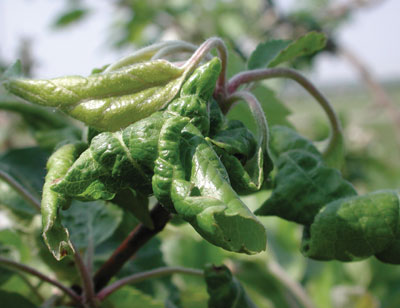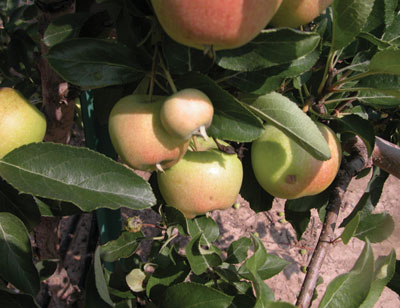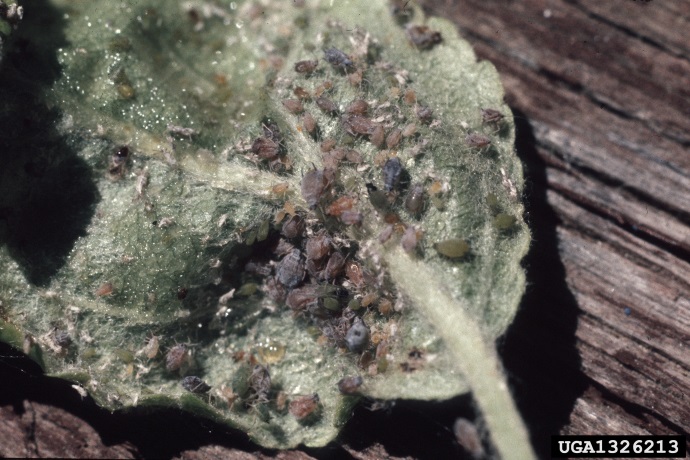
Rosy apple aphid
| Primefact number | Edition | Published | Author |
|---|---|---|---|
| 1227 | Second | Apr 2017 | Plant Biosecurity and Product Integrity |



Rosy apple aphid (Dysaphis plantaginea) is an exotic plant pest not present in Australia. This pest is a serious threat to Australia’s apple industry.
Rosy apple aphid is a major pest of apple trees in Europe and North America.
The aphid is named because the adult’s body is covered with a light waxy coating which is usually tinged a slight purplish or rosy colour.
The lifecycle of the rosy apple aphid involves migration between two hosts, apple trees and the ground weed plantain.
Notifiable status
Rosy apple aphid (Dysaphis plantaginea) is not a notifiable plant pest in NSW.
However, if you suspect Rosy apple aphid (Dysaphis plantaginea):
- Call the Exotic Plant Pest Hotline 1800 084 881
- Email biosecurity@dpi.nsw.gov.au with a clear photo and your contact details
A full list of notifiable plant pests and diseases can be found in Schedule 2 of the NSW Biosecurity Act 2015.
Damage
All apple varieties are attacked by rosy apple aphid although some varieties are more susceptible than others.
The saliva of rosy apple aphid contains a toxin which is injected into a leaf while feeding. The toxin causes apple leaves to curl diagonally from the leaf tip to the leaf base (Figure 1).
The toxin of a closely related species the rosy leaf curling aphid (Dysaphis devecta) causes apple leaves to roll longitudinally and turn bright red.
Leaf curling does not become obvious until petal fall.
Aphid feeding on the leaves of fruit clusters results in bunching, stunting and malformation of the fruit (Figure 2).
Honeydew is produced as aphids feed and this provides a food source for the growth of sooty mould. Sooty mould reduces plant vigour and blemishes the appearance of fruit.
Behaviour
Newly hatched rosy apple aphids are found on new growth in early spring.
Mature rosy apple aphids cluster in curled leaves or on young fruits in spring.
Winged rosy apple aphids migrate to alternative hosts to survive over summer.
Description
Newly hatched rosy apple aphids are dark green. As the rosy apple aphid pass through five nymphal instars they increase in size from 0.4 to 2 mm.
As the aphids grow their colour changes to a rosy brown or purple (Figure 3) and they acquire a powdery white covering.
Eggs are a pale green when first laid then turn a shiny black when mature. Egg size is 0.5 mm and football shaped.
Lifecycle
Rosy apple aphid begins to produce eggs in the autumn and continues to do so until cold temperatures kill all the females. Eggs are laid on twigs, bud axils or in bark crevices.
The aphid overwinters in the egg stage.
The overwintering eggs give rise to only female aphids which give birth to live young.
The aphid population continues to increase on apple until summer. Winged aphids are then produced which migrate to other hosts, such as plantain weeds.
The population of winged rosy apple aphids survive on the alternative hosts over summer and early autumn.
In the late autumn the winged aphids migrate back to apple trees to lay eggs.
Host range
The primary host of rosy apple aphid is apple. Minor hosts include pear and hawthorn.
In summer the rosy apple aphid moves from apple trees to weeds such as plantain. Plantain weeds are common in New South Wales.
Rosy apple aphid requires the presence of plantain weeds such as ribwort to act as host for the summer generations and to enable completion of its lifecycle.
Distribution
Rosy apple aphid is native to Europe, the Middle East and Central Asia.
Rosy apple aphid has been introduced to North and South America.
Spread
Natural spread of rosy apple aphid is by flight or wind assisted dispersal.
Long distance spread occurs by human assisted transportation of infested plant material.
Actions to minimise risks
Put in place biosecurity best practice actions to prevent entry, establishment and spread of pests and disease:
- practice “Come clean, Go clean”
- ensure all staff and visitors are instructed in and adhere to your business management hygiene requirements
- source propagation material of a known high health status from reputable suppliers
- keep records

